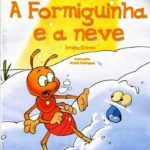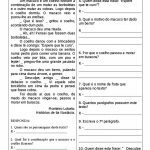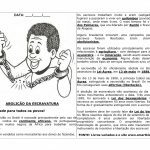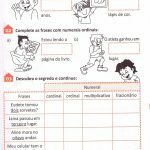where are the answers???
I only see the texts and the questions….
Text Interpretation Activities
the ant and the dove
An Ant went to the riverbank to drink water and, being dragged by the strong current, was about to drown. A Dove that was in a tree over the water, plucked a leaf and dropped it into the current near her. The Ant climbed onto the leaf and floated safely to the bank. A short time later, a bird hunter came under the tree and prepared to place sticks with mistletoe near the Dove that rested on the branches, oblivious to the danger. The Ant, realizing her intention, gave him a sting in the foot. He suddenly dropped his trap and this gave the Dove a chance to fly away safely.
Author: Aesop
Moral of the story: Those who are grateful from the heart will always find opportunities to show their gratitude.
01. This text is a fable because it has characteristics such as
(A) humor and enchanted beings.
(B) instructions and images.
(C) tables and scientific information.
(D) animals as characters and story morale.
02.The text starts by saying A thirsty ant came to the riverbank to drink water. To reach it she had to go down a blade of grass
(The grass.
(B) water.
(C) sheet.
(D) ant.
03. The ant was saved from the current because
(A) the river stopped flowing.
(B) the hunter took it out of the river.
(C) fell a tree branch on which she was leaning.
(D) she climbed a tree leaf thrown into the river by the dove.
04. The ant saw the hunter prepared to hunt the dove at the moment when
(A) struggled in the current.
(B) reached the earth.
(C) hid behind a tree.
(D) was trapped by the hunter's net.
05. At the beginning of the text, it is said that the ant was thirsty. This means that the ant was with
(The hunger.
(B) cold.
(C) headquarters.
(D) heat.
6. “A good deed is paid for with another”. The phrase, written in quotation marks and in larger letters than the text, indicates
(A) the moral of the story.
(B) that the story is over.
(C) the friendship that formed between the dove and the ant.
The rooster that cheated the fox
Interpretation
1-In “A cunning old rooster, realizing...” – the underlined word means:
A( ) noticing
B( ) guessing
C( ) assuming
D( ) preventing
2- In …” realizing the approximation of the fox…” – underlined word may be replaced by:
The proposal
B( ) intention
C( ) voice
D( ) arrival
3- And "perched in a tree" - the underlined word can be replaced by:
A( ) hid
B( ) went up
C( ) jumped
D( ) shrank
4- In “the fox, disappointed, muttered with you” – the underlined word means:
A( ) said in a low voice
B( ) spoke covertly
C( ) grumbled
D( ) thought
5- In “Very good! – exclaimed the rooster." - the underlined word means:
To( )speak out loud and with admiration.
B( ) speak in a reproachful tone.
C( ) speak showing approval.
D( ) speak in an authoritative tone.
6- In “What a beauty the world will be, clean of wars” – the underlined expression is equivalent to:
A( ) among the
B( ) despite the
C( ) far from
D( ) without the
7- In "... and tried to put it fresh", the underlined expression means:
A( ) go to a place that is not so hot.
B( ) go outdoors.
C( ) go out.
D( ) get yourself to safety.
8- In "And shaved" it means:
A( ) left calmly.
B( ) left hastily.
C( ) hid.
D( ) was injured.
9- When the rooster perched on the tree, the fox stayed:
A( ) angry.
B( ) disappointed.
C( ) indifferent.
D( ) happy.
10-Regarding the attitude of the rooster, the fox thought to herself - "Let it be, you rascal, I'll cure you!" – That means she thought of:
A( ) alleviate the suffering of the rooster.
B( ) teach the rooster a lesson.
C( ) cook the rooster.
D( ) make friends with the rooster.
11- By saying "What a beauty the world will be, clean of wars, cruelties and betrayals!" – the rooster refers to:
A( ) disagreements between men.
B( ) fights between him and the fox.
C( ) cruelty committed by the fox towards his friends.
D( ) disagreements that occurred in the animal kingdom.
12- The fox is seen as a very scared, smart animal. In this fable, the fox was shown:
A( ) smarter than the rooster.
B( ) less smart than the rooster.
C( ) as smart as the rooster.
D( ) very smart, in addition to being brave and playful.
13- The name Co-ri-có-có, used by the fox in reference to the rooster, is related:
A( ) at the crowing of the cock.
B( ) to the breed of the rooster.
C( ) to the color of the rooster.
D( ) to the rooster's physique.
the cat's jump
Interpretation
1-"with a band jump, the damned always naughty.”
The word below that has the same meaning as the underlined expression is:
A( ) displayed B( ) freed.
C( ) harmed. D( ) crashed.
2- According to the text, the fox made the following proposal to the cat:
A( ) live in peace.
B( ) fight forever.
C( ) split the rat filets.
D( ) live each one in their own corner.
3- The text shows that both the fox and the mouse have always proved to be:
A( ) slow.
B( ) friends.
C( ) smart.
D( ) fearful.
4- The fox became a student of the cat to:
A( ) having fun with it.
B( ) make peace with him.
C( ) playing, because he felt alone.
D( ) get a chance to devour it.
5- The fox's plan failed because she:
A( ) relied too much on his cleverness.
B( ) was an inattentive student.
C( ) missed the jumps taught.
D( ) acted without thinking
At the bicharada's school, Mrs. Corujinha, because she is very knowledgeable, is the teacher.
Donkey can't read yet. Laziness sleeps all the time and has learned nothing to this day.
Hyena just laughs. Monkey just clowns around.
The student who gives the most work is the vain Pavão. He doesn't sit still in his desk, he walks all the time, back and forth, with his colorful tail.
One day the Peacock said:
– How beautiful I am! See my feathers!
The Monkey did a pirouette and replied:
– O vain animal! Look at your feet. See how ugly they are.
Peacock looked at his feet, got a huge fright and was very sad until the end of the class.
(Adaptation from Aesop's Fable)
1. What is the title of the text?
2. Who are the characters?
3. Where was the text taken from?
.4. Who is the school teacher and why?
5. What does the text tell you about Donkey?
6. Why is Peacock the student who gives the most work?
7. In how many paragraphs was the text written?
8. Remove from the text the sentence that shows what the Monkey responded to Peacock:
the windy day
The jaguar was dying to devour the rabbit.
Master Rabbit, who was very smart, devised a plan to end the chase. He saw the jaguar approaching and began his plan. He picked up the machete and began to gather vines, hurried and anxious.
The jaguar thought that was very strange and asked:
— Why so many vines, master rabbit?
"Well, don't you know, comadre jaguar?" It turns out that Tupã is furious with all the animals in the forest and will send a terrible punishment! Soon begins the Day of the Final Wind!
— Day of the Final Wind?! asked the jaguar. - What is it?
— It's just that it's going to be windy like never before in the world. It will be so windy that no animal will be able to stand on the ground. It's all blown up!
- How horrible! the dumb jaguar was horrified. — And what can you do?
"Anyone who's not a fool has to ask someone to tie him up tightly to a thick tree." I'm gathering these vines here and I'm running home to tie up all my little children!
The jaguar was terrified:
— Help me, bunny friend! I don't want to be blown away by the gale. Tie me up first!
— Sorry, comadre jaguar, but I can't. I have to run home and tie up my little kids.
— Don't do this to me, compadre rabbit, please! Tie me up!
The jaguar insisted so much that the rabbit, after pretending to refuse, ended up agreeing. He tied the damned jaguar very well tied, with a lot of vines, to the strongest tree in the forest!
And he went home happy, leaving the dumb jaguar very well tied up and very satisfied, waiting for the wind that would never appear...
Pedro Flag. The day of the wind. Sao Paulo
1) The rabbit made a plan because he had a problem with the jaguar. What was this problem?
2) What was the plan?
3) According to the rabbit, who was furious with the animals and what was going to happen?
4) How many paragraphs is the text made up of?
5) What is the punctuation mark that starts the fourth paragraph? What is it for?
6) What is the punctuation mark that ends the fourth paragraph? What is it for?
7) Did the rabbit's plan work? Because?
8) Give the text another title.
9) The text says that master rabbit was very smart and that the jaguar was “dumb”. You agree? Because
Did you like it? Share this post on your social network
 THE ANT AND THE SNOW
THE ANT AND THE SNOW
 READING ACTIVITIES WITH TEXTS AND QUESTIONS
READING ACTIVITIES WITH TEXTS AND QUESTIONS
 ACTIVITIES ON THE ABOLITION OF SLAVERY
ACTIVITIES ON THE ABOLITION OF SLAVERY
 TEXT: THE MAGIC OF THE ALPHABET TO PRINT
TEXT: THE MAGIC OF THE ALPHABET TO PRINT
 Activities With Dotted Vowels for Printing
Activities With Dotted Vowels for Printing
 Activities with Cardinal, Ordinal, Fractional and Multiplicative Numerals
Activities with Cardinal, Ordinal, Fractional and Multiplicative Numerals
where are the answers???
I only see the texts and the questions….
This site uses Akismet to reduce spam. Learn how your comment data is processed.

